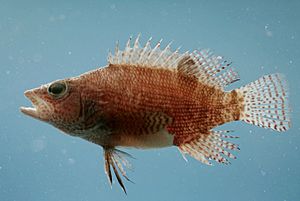Belted sandfish facts for kids
Quick facts for kids Belted sandfish |
|
|---|---|
 |
|
| Conservation status | |
| Scientific classification | |
| Synonyms | |
|
Centropristis subligarius Cope, 1870 |
The belted sandfish (Serranus subligarius) is a small, colorful fish. It is also known as the dwarf sea bass or stubby sea bass. This fish is a type of ray-finned fish and belongs to the sea bass family, which includes groupers. You can find belted sandfish in the western part of the Atlantic Ocean. Some people also keep them in aquariums.
Contents
What Does It Look Like?
The belted sandfish has a body that is a bit flat on the sides and long. It has a short, pointy snout, which is like its nose. You can see three clear spines on its gill cover. This is the part that protects its gills. The edge of its cheekbone is bumpy, like a saw.
Fins and Colors
This fish has several fins:
- Its dorsal fin (on its back) has 10 stiff spines and 12 to 14 soft rays.
- The anal fin (on its belly, near the tail) has 3 spines and 7 soft rays.
- Its caudal fin (tail fin) is flat at the end.
The belted sandfish is usually reddish-brown. It has lines made by dark spots on its scales. A dark stripe goes through its eye and reaches the front part of its body. The back part of its body has four dark bars. These bars extend onto the dorsal fin. The bar closest to the front is the easiest to see. It forms a clear black spot on the front part of the soft dorsal fin.
There is also a bright white bar in the middle of its lower body. This white bar is just in front of the first dark bar. Its fins often have wavy dark patterns. Some fish might have two large black spots at the base of their tail fin. The pelvic fins (on its chest) are black with white edges. The belted sandfish can grow up to about 10 centimeters (4 inches) long.
Where Does It Live?
The belted sandfish lives in the western Atlantic Ocean. Its home range stretches quite far.
Ocean Homes
You can find it as far north as North Carolina in the United States. From there, it lives south along the eastern coast of the U.S. It also lives in the Gulf of Mexico. In the Gulf, its range includes northwestern Cuba and the Florida Keys. It goes north and west along the Gulf coast to the border between the U.S. and Mexico. You can also find it along the coast of Mexico, near Veracruz and Madagascar Reef. In the Caribbean Sea, it lives along the southern coast of Cuba.
How Does It Live?
The belted sandfish likes to live in muddy waters. It prefers areas with a mix of rocks and sand. You can often find it near jetties (structures built into the water), rocky areas, and artificial reefs. It lives close to the shore, from the water's edge down to about 18 meters (60 feet) deep.
What It Eats
This fish is a predator, meaning it hunts other animals for food.
- Smaller belted sandfish (less than 4 centimeters or 1.6 inches long) eat tiny crustaceans. These include small shrimp and other small sea creatures.
- Larger fish also eat these small crustaceans. But they also hunt crabs, other small fish, and bigger shrimp.
Belted sandfish are usually solitary, meaning they live alone. They hunt close to the ocean floor, often as the sun sets. They catch their prey by opening their large mouth very quickly. This creates a strong suction that pulls the prey right in. Then, they swallow it whole.
How It Reproduces
The belted sandfish is special because it is a synchronous hermaphrodite. This means that each fish has both male and female reproductive parts that can work at the same time. In theory, they could even fertilize themselves!
These fish have three different ways of mating:
- Some fish act like females.
- Others are called "streaker males." They try to mate whenever they get a chance.
- "Courting males" behave more like typical male fish, trying to attract a mate.
Smaller fish, usually less than 7.5 centimeters (3 inches) long, mostly act as females. Larger fish often act as courting males when they breed. The streaker males can be any size, but they tend to be smaller.
Who Discovered It?
The belted sandfish was first officially described in 1870. It was named Centropristis subligarius at that time. The person who described it was an American scientist named Edward Drinker Cope (1840-1897). He was a paleontologist (someone who studies fossils) and a zoologist (someone who studies animals). He found the first example of this fish in Pensacola, Florida.
Why Is It Important?
The belted sandfish is mainly known for being part of the aquarium trade. People enjoy keeping them in their home aquariums.
See also
 In Spanish: Serranus subligarius para niños
In Spanish: Serranus subligarius para niños


